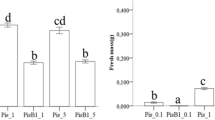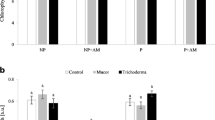Abstract
Allelopathy has been implicated as a factor contributing toward failure of black spruce (Picea mariana) regeneration in Kalmia angustifolia-dominated sites in eastern Canada. Several phenolic acids of Kalmia origin inhibit primary root growth of black spruce. We tested the hypothesis that some well-adapted conifer ectomycorrhizae can degrade and detoxify water-soluble phenolic compounds produced by Kalmia and use the degraded products as a carbon source to stimulate growth. We found that hyphal growth of Paxillus involutus, a common ectomycorrhizal fungus of black spruce, was stimulated by water leachates of Kalmia leaf and litter. An equimolar mixture of three phenolic acids (ferulic, o-coumaric, and o-hydroxyphenylacetic acid), commonly found in Kalmia, had no negative effects on fungal growth at 1 mM concentration. The o-hydroxyphenylacetic (o-HPA) acid, which is known to be toxic to black spruce, was found to stimulate the growth of Laccaria laccata, L. bicolor, and P. involutus (isolates 211804 and 196554) by 38.4, 29.3, 25.0, and 18.9%, respectively, at 1 mM. Pure ferulic, o-coumaric, and o-HPA acids were degraded by 100, 98, and 79.5%, respectively, within 10 d in the presence of P. involutus 211804. However, L. laccata could not tolerate high concentrations of the Kalmia leachates. P. involutus and L. bicolor used o-HPA acid as a carbon source when cultured in noncarbon nutrient medium. The 0.5 and 0.2 mM o-HPA acid inhibited the root growth of black spruce. However, after solutions had been exposed to a culture of P. involutus, they had no significant effect on seedling growth of black spruce. We concluded that some ectomycorrhizal fungi, such as P. involutus and L. bicolor, are able to degrade Kalmia phenolics. Our findings point to a mechanism by which ectomycorrhizal species can control species interactions in higher plants by changing the rhizosphere chemistry.





Similar content being viewed by others
References
Bending, G. D. and Read, D. J. 1997. Lignin and soluble phenolic degradation by ectomycorrhizal and ericoid mycorrhizal fungi. Mycol. Res. 101:1348–1354.
Berg, B. and Dise, N. 2004. Calculating the long-term stable nitrogen sink in northern European forest. Acta Oecol. 26:15–21.
Boufalis, A. and Pellissier, F. 1994. Allelopathic effects of phenolic mixtures on the respiration of two spruce mycorrhizal fungi. J. Chem. Ecol. 20:2283–2289.
Boufalis, A., Pellissier, F., and Trosset, L. 1994. Responses of mycorrhizal fungi to allelopathy: Cenococcum geophilum and Laccaria laccata growth with phenolic acids. Acta Bot. Gall. 141:547–550.
Callaway, R. M. and Ridenour, W. M. 2004. Novel weapons: invasive success and the evolution of increased competitive ability. Front. Ecol. Environ. 2:436–443.
Colpaert, J. V. and Van Assche, J. A. 1993. The effects of cadmium on ectomycorrhizal Pinus sylvestris L. New Phytol. 123:325–333.
Coté, J. F. and Thibault, J. R. 1988. Allelopathic potential of raspberry foliar leachates on growth of ectomycorrhizal fungi associated with black spruce. Am. J. Bot. 75:966–970.
Denny, H. J. and Wilkin, D. A. 1987. Zinc tolerance in Betula spp. IV. The mechanism of ectomycorrhizal amelioration of zinc toxicity. New Phytol. 106:545–553.
Fries, L. L. M., Pacovsky, R. S., Safir, G. R., and Siqueira, J. O. 1997. Plant growth and arbuscular mycorrhizal fungal colonization affected by exogenously applied phenolic compounds. J. Chem. Ecol. 23:1755–1767.
Gallet, C. and Pellissier, F. 1997. Phenolic compounds in natural solutions of a coniferous forest. J. Chem. Ecol. 23:2401–2412.
Handley, W. R. C. 1963. Mycorrhizal association with Calluna heathland afforestation. Bull. For. Commun. 36:1–70.
Inderjit and Mallik, A. U. 1999. Nutrient status of black spruce (Picea mariana (Mill) BSP forest soils dominated by Kalmia augustifolia L. Acta Oecol. 20:87–92.
Lynn, D. G. and Chang, M. 1990. Phenolic signals in cohabitation: Implications for plant development. Annu. Rev. Plant Physiol. Plant Mol. Biol. 41:497–526.
Mallik, A. U. 1987. Allelopathic potentials of Kalmia angustifolia to black spruce (Picea mariana). For. Ecol. Manage. 20:43–51.
Mallik, A. U. 2001. Black spruce growth and understory species diversity in contiguous plots with and without sheep laurel (Kalmia angustifolia). Agron. J. 93:92–98.
Mallik, A. U. and Newton, P. F. 1988. Inhibition of black spruce seedling growth on the forest floor substrates of central Newfoundland. For. Ecol. Manage 23:273–283.
Mallik, A. U. and Zhu, H. 1995. Overcoming allelopathic growth inhibition by mycorrhizal inoculation, pp. 39–57, in Inderjit, K. M. M. Dakshini, and F. A. Einhellig (eds.). Allelopathy: Organisms, Processes, and Applications. American Chemical Society, Washington, DC.
Mallik, A. U., Zhu, H., and Park, Y. G. 1998. Overcoming Kalmia induced growth inhibition of Picea mariana by mycorrhizal inoculation. J. Korean For. Soc. 87:429–444.
Marx, D. H. 1969. The influence of ectotrophic mycorrhizal fingi on the resistance of pine roots to pathogenic infection. Antagonism of mycorrhizal fungi to root pathogenic fungi and soil bacteria. Phytopathology 59:153–163.
Marx, D. H. and Kenney, D. E. 1982. Production of ectomycorrhizal fungus inoculum, pp. 224, in N. C. Schenck (ed.). Methods and Principles of Mycorrhizal Research. American Phytopathological Society.
Nehls, U., Wiese, J., and Hampp, R. 2000. External super concentration as a signal controlling gene expression, pp. 19–26, in G. K. Podila and D. D. Douds Jr. (eds.). Current Advances in Mycorrhizae Research. American Phytopathological Society, St. Paul, MN.
Pellissier, F. 1993. Allelopathic effects of phenolic acids from humus solutions on two spruce mycorrhizal fungi: Cenococcum graniforme and Laccaria laccata. J. Chem. Ecol. 19:2105–2114.
Pellissier, F. 1994. Effects of phenolic compounds in humus on the natural regeneration of spruce. Phytochemistry 36:865–867.
Robinson, R. K. 1972. The production by roots of Calluna vulgaris a factor inhibitory to growth of some mycorrhizal fungi. J. Ecol. 60:219–224.
Siqueira, J. O., Safir, G. R., and Nair, M. G. 1991. Significance of phenolic compounds in plant–soil–microbial system. Crit. Rev. Plant Sci. 10:63–121.
Souto, C., Pellissier, F., and Chiapusio, G. 2000. Allelopathic effects of humus phenolics on growth of mycorrhizal fungi. J. Chem. Ecol. 26:2015–2023.
Thiffault, N., Titus, B. D., and Munson, A. D. 2004. Black spruce seedlings in a Kalmia–Vaccinium association: microsite manipulation to explore interactions in the field. Can. J. For. Res. 34:1657–1668.
Thompson, I. D. and Mallik, A. U. 1989. Moose browsing and allelopathic effects of Kalmia angustifolia on balsam fir regeneration in central Newfoundland. Can. J. For. Res. 19:524–526.
Vivanco, J. M., Bais, H. P., Stermitz, F. R., Thelen, G. C., and Callaway, R. M. 2004. Biogeographical variation in community response to root allelochemistry: novel weapons and exotic invasion. Ecol. Lett. 7:285–292.
Wallstedt, A., Coughlan, A., Munson, A. D., Nilsson, M.-C., and Margolis, H. A. 2002. Mechanisms of interaction between Kalmia angustifolia cover and Picea mariana seedlings. Can. J. For. Res. 32:2022–2031.
Yamasaki, S. H., Fyles, J. W., Egger, N. E., and Titus, B. D. 1998. The effect of Kalmia angustifolia on growth, nutrition, and ectomycorrhizal symbiont community of black spruce. For. Ecol. Manage. 105:197–207.
Zhu, H. and Mallik, A. U. 1994. Interactions between Kalmia and black spruce: Isolation and identification of allelopathic compounds. J. Chem. Ecol. 20:407–421.
Acknowledgments
We acknowledge the financial support from the Natural Science and Engineering Research Council (NSERC) discovery grant (to AUM) and the National Natural Science Foundation of China (30270230, 30370246), Guangdong Natural Science Foundation of China (039254, 04105977), the National 973 project of China (2006CB100200), Program for New Century Excellent Talents in University (to RSZ). We thank Dr. Christine Gottardo, Debbie Leach, and Andrea Aguirre of the Chemistry Department, Lakehead University, and Haihong Bi of the Department of Ecology, South China Agricultural University for their help in HPLC analyses, and Dr. Ed Setliff of the Faculty of Forestry and the Forest Environment, Lakehead University for his cooperation during the inoculation experiments. Comments of two anonymous reviewers, the journal editor, Drs. Robert D. Guy and Jenelle Curtis (Faculty of Forestry, University of British Columbia), Leonard Hutchison, and Brian McLaren (Faculty of Forestry and the Forest Environment, Lakehead University) were helpful in revising the manuscript.
Author information
Authors and Affiliations
Corresponding author
Rights and permissions
About this article
Cite this article
Zeng, R.S., Mallik, A.U. Selected Ectomycorrhizal Fungi of Black Spruce (Picea mariana) can Detoxify Phenolic Compounds of Kalmia angustifolia . J Chem Ecol 32, 1473–1489 (2006). https://doi.org/10.1007/s10886-006-9063-6
Received:
Revised:
Accepted:
Published:
Issue Date:
DOI: https://doi.org/10.1007/s10886-006-9063-6




